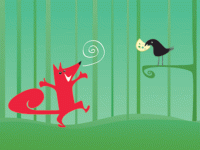Common Core, Critical Thinking and Aesop’s Fables
Your content has been saved!
Go to My Saved Content.Critical thinking is the means by which we objectively analyze the pros and cons of a situation in order to make informed decisions. It is a fundamental skill that is of such importance that many colleges and universities require their freshman students to complete an introductory course. The Common Core Standards also recognize the value of critical thinking, declaring it as one of the explicit skills children are to learn. This leaves teachers with the difficult task of teaching this complex skill to elementary school children.
How will children learn critical thinking? The answer is: "It depends."
I am not trivializing the topic. I am however, suggesting that children must first understand the concept of "it depends" and how it relates to their daily lives, if they are to think critically.
As we all know, young children are most comfortable with clear rules and "black and white" thinking. The idea that a situation may have multiple answers that depend upon variables and context is a foreign and complex notion to children (and even many adults). Critical thinking begins with the recognition that there are multiple points of view. Each point of view is based on a specific context which, by its very nature, emphasizes one set of characteristics while de-emphasizing the remaining characteristics. Critical thinking is the evaluation and analysis of the differing points of view for the purpose of determining which one is "more valid."
The Basic Story
Fables are well suited for presenting a situation from at least one point of view. That is because fables are allegorical stories that teach lessons about life. As such, they present a typical problem that children readily understand and can relate to. One or more characters, often animals, resolve the problem, thereby presenting the evaluation and analysis from a singular point of view. In this way, fables provide the framework in which the concept of "it depends" can be introduced to young children. Introducing the concept is as simple as asking a question that causes the child to view the story from another perspective. It is imperative, however, that the child fully understands the message of the fable as presented from the original point of view.
Aesop's fables are timeless treasures that have been taught to children for many centuries. They have stood the test of time and are packed with wisdom. "The Boy Who Cried Wolf" is one of the most well known of Aesop's fables. Children can easily relate to the shepherd boy who is bored and is looking for attention. They can also relate to the unintended consequences of their actions as happened with the shepherd boy who lost a lamb to the wolf because the villagers stopped believing his cries for help.
What if the shepherd boy actually saw the wolf each time he cried for help? What if the wolf was cunning and hid from the villagers? When we ask these questions, the meaning of the fable changes drastically. It is no longer a fable about the importance of honesty. Instead, it is a fable about the villagers unjustly accusing the shepherd boy of dishonesty. It is a fable about the dangers of jumping to conclusions without knowledge of all the facts.
Other Points of View
"What if" questions force an analysis and evaluation from a completely different point of view. Those questions actually create a framework through which the child will begin to think critically. The different perspective is the catalyst for critical thinking, and it helps the child realize that "it depends."
As you know, there are many adaptations of "The Boy Who Cried Wolf." Some simply state that the shepherd boy cried wolf and omit his motives, while other versions declare that the boy knowingly lied. The questions above are only appropriate for those versions of the story where it is not specifically stated that the boy did not see the wolf.
Be prepared for a great discussion as you reread those sections of the story that open the door to the "what if" questions. Provoking the children to think critically via "what if" questions can be applied to any of Aesop's fables. Older children can even be asked to offer their own "what if" questions. The discussions will be fun and lively. Don’t forget to conclude with a discussion on "it depends."
